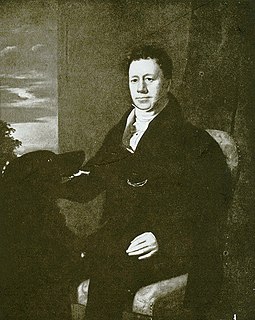
The Slavery Abolition Act 1833 abolished slavery in most parts of the British Empire. This Act of the Parliament of the United Kingdom expanded the jurisdiction of the Slave Trade Act 1807 and made the purchase or ownership of slaves illegal within the British Empire, with the exception of "the Territories in the Possession of the East India Company", Ceylon, and Saint Helena. The Act was repealed in 1997 as a part of wider rationalisation of English statute law; however, later anti-slavery legislation remains in force.

John Campbell, 2nd Marquess of Breadalbane,, styled Lord Glenorchy until 1831 and as Earl of Ormelie from 1831 to 1834, was a Scottish nobleman and Liberal politician.

George Hibbert was an English merchant, politician, slave-owner, ship-owner, amateur botanist and book collector. With Robert Milligan, he was also one of the principals of the West India Dock Company which instigated the construction of the West India Docks on London's Isle of Dogs in 1800. He also helped found the Royal National Lifeboat Institution in 1824.

The Slave Compensation Act 1837 was an Act of Parliament in the United Kingdom, signed into law on 23 December 1837. It authorised the Commissioners for the Reduction of the National Debt to compensate slave owners in the British colonies of the Caribbean, Mauritius, and the Cape of Good Hope in the amount of approximately £20 million for freed slaves. Based on a government census of 1 August 1834, over 40,000 awards to slave owners were issued. Since some of the payments were converted into 3.5% government annuities, they lasted until 2015.

Slavery in Great Britain existed prior to the Roman occupation and until the 12th century, when chattel slavery disappeared, at least for a time, following the Norman Conquest. Former indigenous slaves merged into the larger body of serfs in Britain and no longer were recognised separately in law or custom.
Benjamin Greene was the founder of Greene King, one of the United Kingdom's largest brewing businesses.
Sir John Rae Reid, 2nd Baronet (1791–1867) was a British merchant and financier. He was a Tory and Conservative politician who sat in the House of Commons between 1830 and 1847.
Benjamin Buck Greene was a British banker and financier. He inherited a large fortune derived from the Atlantic slave trade and the sugar industry in the Caribbean, later becoming one of London's leading merchants and shipowners. He served as a director of the Bank of England for fifty years from 1850, also serving as deputy governor (1871-3) and governor (1873–5).
James Blair was a Scots-Irish owner of plantations in the West Indies. He entered Parliament as a Tory in 1818 to protect the interests of slave-owners. Blair sat in the House of Commons from 1818 to 1830, and later from 1837 to 1841.
Sheffield Neave (1799–1868) was an English merchant and Governor of the Bank of England from 1857 to 1859.
Alfred Latham (1801–1885) was an English businessman and banker, born in Camberwell to Thomas Latham (1746–1818), a merchant and plantation owner, and his wife, Ann Jones. Inheriting wealth, Latham went into business in 1824, and went into partnership in what became the Arbuthnot Latham bank in 1833, with John Alves Arbuthnot (1802–1875).

The Great Western Cotton Factory was opened on a site in Barton Hill, Bristol in April 1838 to spin and weave cotton into cloth. The cotton processed at the factory was brought from America to the port of Liverpool and carried by water to Bristol. It was the only example of a cotton mill in the south west of England, most other factories being in Lancashire, Yorkshire, Cheshire and Derbyshire.
Samuel Sandbach was successively Bailiff, Coroner and Mayor of Liverpool, as well as High Sheriff of Denbighshire and a Justice of the Peace for Lancashire. He made his fortune as a merchant in a partnership that traded with the West Indies and owned slaves.
Sandbach, Tinne & Company, together with its associate firms McInroy, Parker & Company and McInroy, Sandbach & Company, was a business whose roots can be traced back to 1782. Having begun business in the cotton trade, the firms moved into sugar products and exported coffee, molasses, rum and sugar from the West Indies. They owned ships and plantations, and engaged in both slavery and transport of indentured labour.
Charles McGarel (1788–1876) was an Ireland-born Ulster-Scots merchant and slave owner. In 1833 the British Government abolished slavery and compensated owners, such as McGarel, who became a major beneficiaries of this scheme. With his wealth he conducted business in the City of London, funded civic works in his home town of Larne, County Antrim and bought land and property in Ireland. Having no children, he left his estate to his brother-in-law, James Hogg, on condition that he integrate McGarel into his family name, becoming James McGarel-Hogg, later Lord Magheramorne.
William Hibbert (1759–1844) was the sixth son of Robert Hibbert (1717–1784) and Abigail Scholey. With his brother George Hibbert and cousin Robert Hibbert (1769–1849) William was a partner in the West Indian merchant house Geo. Rob. & Wm. Hibbert. The firm was involved in the slave trade and principally with the shipping, insurance and distribution of sugar from the West Indies.

James Ewingof Strathleven (1775–1853), FRSE, DLL, was Lord Provost of Glasgow (1832–1833), and MP for Glasgow (1832–1835), a plantation owner, slave-holder and West Indies merchant.
William Atherton, was a merchant and wealthy landowner from Lancashire, England, who operated and co-owned sugar plantations in the former Colony of Jamaica. He was a slave owner, as well as an importer of slaves from Africa.
Anna Gamon, or Anne Gamon, was an English aristocrat and slave owner. She married James Brydges, the third Duke of Chandos.
Green Park Estate was one of several sugar plantations owned by William Atherton and his heirs. It was located in Trelawny Parish, south of Falmouth, Jamaica. By the early nineteenth century, at least 533 people were enslaved there producing mainly sugar and rum.











